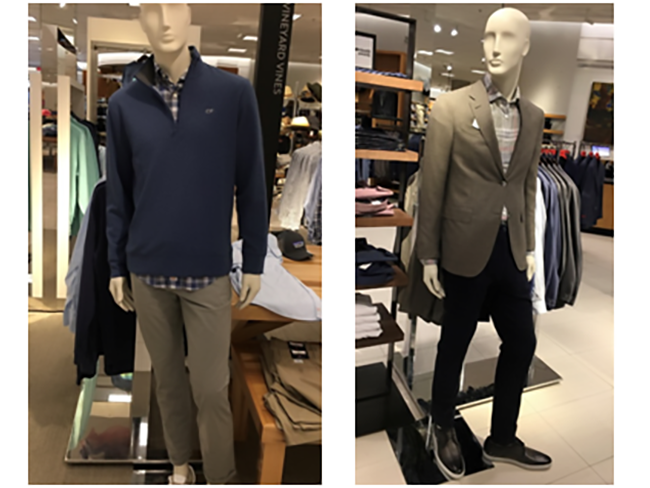When it comes to leadership, advancing in your career, and projecting an aura of confidence and capability, people tend to look for leadership coaching and training. As they build their leadership skills, there’s one critical component that’s frequently overlooked:
Physical appearance. Image. Presence.
In our increasingly casual society, you may think that what you wear and how you style your hair don’t have a bearing on your career.
You’re wrong.
As humans, we’re visual creatures. You may have no interest whatsoever in fashion, but you’re like a horse that stumbles right out of the gate if you try to ignore it. Sure, there may be other facets of leadership that you need to work on. But without a credible, professional image, you’ll never catch up.
Who would you hire?

Imagine you have a water leak in your home. You call three plumbers, based on recommendations from your neighbors. The first one comes late, directly from another job that ran long. He’s covered in mud and tracks it all over your carpets. The second arrives right on time, wearing a three-piece suit and bearing slick marketing materials. He doesn’t bother to remove his wingtips as he walks through your home and glances under your sink at the leak. The third plumber arrives on time dressed in clean jeans and a t-shirt. He takes off his boots and slides under the sink to quickly diagnose the problem.
All three promise to send you a quote within the next day or two. Based on those descriptions, which plumber do you expect to hire?
In all likelihood, you’ll have the most favorable impression of the third plumber. He showed respect for you and your home while dressing appropriately for his trade. The first plumber seems like he doesn’t manage his time well. The second, the plumber in the suit, seems like he’ll be too pricey and won’t get his hands dirty. He’s likely to send a junior plumber the day of job.
Now let’s translate the plumber example into a corporate environment. Lydia is a senior manager at a bank. She’s been in her role for three years, and her supervisor has recommended her for a director-level position for a new department that’s forming. She’s invited to a cross-functional strategy meeting so that senior leadership can see her in action. As a conservative, formal institution, the bank’s leadership team regularly dresses in suits. Lydia comes to the strategy meeting wearing a long, flowing, flowered skirt and a pink peasant-style top. Her long hair hangs down her back and she wears large, noisy jewelry. She says a lot of smart things during the meeting. Unfortunately, what the senior leaders remember most is their first impression of Lydia: what is a woman dressed like this doing in a senior leadership meeting at our bank?
This is often when I’m called in to help. Lydia’s supervisor will say something like, “I have a leader who has all the smarts and skills, but she just doesn’t have the polish that our senior leadership wants to see. Can you help?”
In most cases, the mismatch isn’t as obvious as Lydia’s dress compared to the senior leaders. More commonly, a leader started out as entry level, moved up through the ranks, and didn’t update his or her look in the process.

Look at the differences in the two photos above. The mannequin on the left shows a business casual look appropriate for an individual contributor in many organizations. By swapping the pullover for a jacket in the example on the right, the look is immediately upgraded.
Three wardrobe elements that will make or break your look
When it comes down to choosing clothes that fit the look you’re trying to achieve, it’s less about the brand (or even price) and more about three key elements:
- Fit: Does the garment fit your body properly? Is the style flattering to your body type? Is the item hemmed to the appropriate length? Are you adequately covered?
- Color: Many women gravitate to black because it’s universally flattering. Blue tends to be timeless and also offers a variety of shades. In the corporate world, muted shades are typically preferred.
- Fabric: Texture and patterns can help muted colors become richer and more flattering if done well. The quality of the fabric will also affect how it hangs on your body and what body parts are accentuated.
Of the three elements, fit is the most critical. Consider the shoulders, waist, and hem length. If these three areas are on point, you’ll look smart, contemporary, and elegant. The fabric is closely linked to fit because it determines how the garment feels. Do you feel comfortable in the outfit? Your clothes shouldn’t be a hinderance, feeling too heavy or light. Color brings in the finer points that will give off a warm or cool temperature.
The breaking points tend to fall around the shoulders, particularly where jackets are concerned. Jacket lapels, for both men and women, have changed dramatically in recent years, and are a telltale sign of a dated look (or one that’s too fashion-forward). In order to see the differences for yourself, look in recent fashion magazines and browse a variety of stores, noticing common trends.
Building a wardrobe that works for you
There are many approaches to building a functional wardrobe for your work life. Capsule wardrobes have become popular in recent years because they help you to own fewer pieces that all work together in various combinations. If the capsule approach doesn’t appeal to you, try using the threes rule. When you see a piece you wish to purchase, ensure you have at least three existing pieces in your wardrobe that you can wear with it. If you don’t, purchase the three pieces you’ll need along with the first piece. If you don’t plan to shop frequently, stick with classic pieces that won’t look dated in a year or two. Also, don’t forget to purchase items for business social events.
Many contemporary, high-profile leaders have a signature look, which is a fancy way of saying that they wear the same things every day. Steve Jobs is probably the best-known example—in public and private, he wore a simple black turtleneck and jeans each day. One reason for choosing a signature look is that it helps you avoid decision fatigue. When you’re in a high-pressure leadership role, deciding what to wear in the morning is one less decision to make each day, giving you just a little more brainpower for the more critical decisions you’ll make. If you decide to choose a signature look, make sure it’s made up of pieces in which you feel comfortable and confident.
Stand out for the right reasons
If you’ve been overlooked for a promotion and know you have the mental ability to do the job, consider whether something about your appearance is holding you back. Do you fit in with the senior leaders in your organization? Have you updated your look to reflect your current position, status, age, and body type? What’s on the inside of a person counts—but the exterior can be a powerful barrier that’s easy to overcome with the right fashion choices.
Anna Wildermuth is an Executive Coach and Image Consultant who helps executive clients enhance their credibility, strengthen their relationship-building skills, and understand the many sensitivities and social cues that exist in business. Learn more at https://annaexecutivecoach.com/
